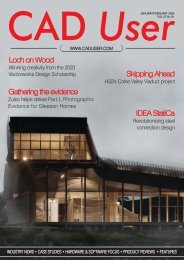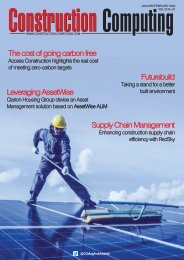You also want an ePaper? Increase the reach of your titles
YUMPU automatically turns print PDFs into web optimized ePapers that Google loves.
TECHNOLOGYfocus<br />
PIM to AIM<br />
David Chadwick recently discussed the evolution of management needs - from the design and<br />
construction of a building to its occupation and maintenance - with Mervyn Richards<br />
We talk glibly about using<br />
information accrued during the<br />
design and construction<br />
processes of a project to build an asset<br />
information model to 'operate' the<br />
building, but the information required and<br />
the management processes involved in<br />
each part of the project are somewhat<br />
dissimilar, to say the least. Given that the<br />
whole of life of a project is many times the<br />
duration of its construction, it might be<br />
useful to understand more fully the needs<br />
of the Asset Manager. I am grateful to<br />
Mervyn Richards OBE for his help in<br />
providing me with a comprehensive<br />
background on CDEs and their role in the<br />
procurement and delivery processes of a<br />
project, and an insight into the<br />
development of the sets of information<br />
required to operate and maintain the<br />
project throughout its complete lifecycle.<br />
The Common Data Environment (CDE),<br />
is a process that manages, collates and<br />
distributes shared information collated<br />
during the design and development<br />
phases of any project that uses BIM<br />
processes and workflows. It produces a<br />
Project Information Model (PIM) which is<br />
handed over to the client after<br />
construction, providing a full record of the<br />
projects audit trail, construction<br />
processes, components and materials,<br />
published documents and<br />
communications between members<br />
involved in the project. Handed into the<br />
clients' 'custody', the PIM is there to be<br />
used in the event of a failure in its intended<br />
purpose and used as evidence in the<br />
event of litigation, or to support ongoing<br />
construction projects on the project.<br />
Some data is added directly to objects<br />
within the 3D model or extracted and<br />
added to other information within the<br />
Construction Operations Building<br />
information exchange (COBie)<br />
spreadsheet, and handed over at project<br />
completion and integrated with asset<br />
management systems, such as computeraided<br />
facilities management (CAFM) or<br />
asset management databases. Projectrelated<br />
documentation, such as operation<br />
and maintenance manuals, as-built<br />
drawings and data enriched models in<br />
industry foundation classes (IFC) format,<br />
will also be provided.<br />
Although it will form the basis of the<br />
Asset Information Model (AIM), the<br />
information available within the CDE and<br />
subsequently the PIM, is not totally<br />
compatible with the information required<br />
by Asset Managers tasked to manage the<br />
purpose or function of a building. Facilities<br />
or Asset Managers therefore need to keep<br />
a separate record of the maintenance and<br />
operation of a building, creating a<br />
separate audit trail maintained by<br />
whichever software solution is related to<br />
each function - either within the AIM, or<br />
separately, dependent on the software<br />
being used.<br />
To maintain an AIM within a BIM<br />
workflow, information requirements should<br />
also include organisation information<br />
requirements (OIR), asset information<br />
requirements (AIR) and, of course,<br />
exchange information requirements (EIR)<br />
to facilitate sharing of information between<br />
processes and procedures.<br />
18<br />
<strong>Jul</strong>y/<strong>Aug</strong>ust <strong>2022</strong>

















